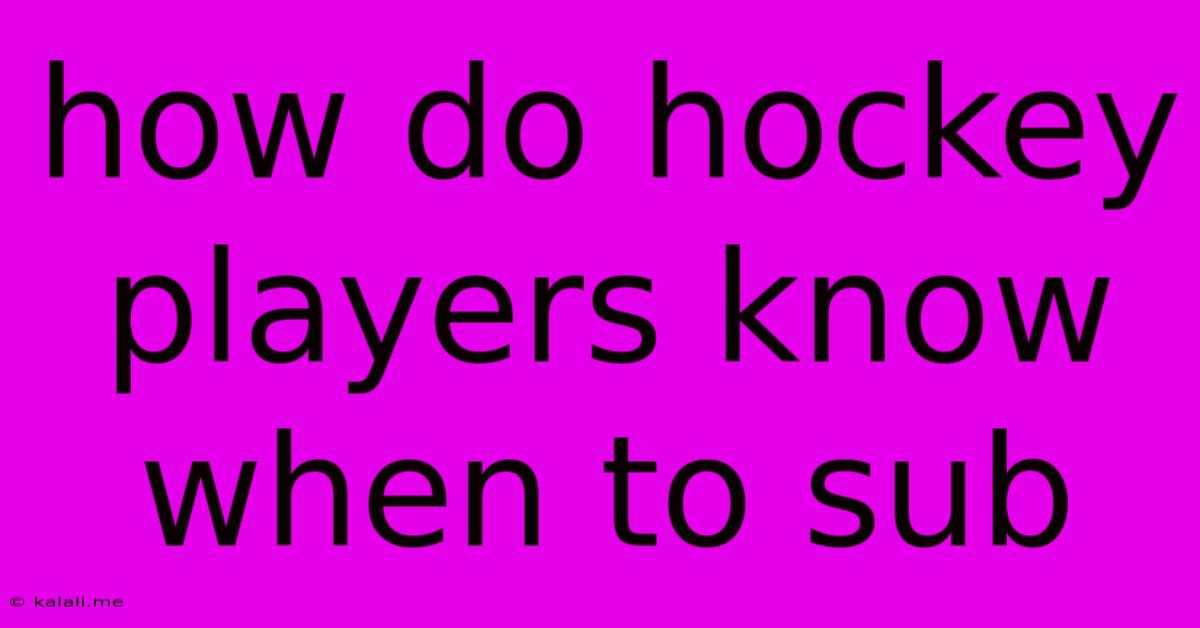How Do Hockey Players Know When To Sub
Kalali
May 25, 2025 · 3 min read

Table of Contents
How Do Hockey Players Know When to Sub? The Art and Science of Line Changes
Knowing when to make a line change is crucial in hockey. It's not just about being tired; it's a complex interplay of strategy, player performance, and game situation. This article delves into the factors that influence a player's decision to head to the bench, examining both the player's perspective and the coaching staff's role.
The Player's Perspective: Reading the Game
While coaches call lines, individual players also play a significant role in recognizing when a substitution is necessary. Experienced players develop a keen sense of their own physical and mental state, allowing them to anticipate the need for a break. This involves several factors:
-
Physical Fatigue: This is the most obvious cue. Burning lungs, heavy legs, and decreased reaction time are clear signs that a player needs a rest. Maintaining speed and agility is paramount in hockey, and fatigue drastically impacts performance. Pushing through exhaustion can lead to mistakes and injuries.
-
Mental Fatigue: Hockey requires intense focus and concentration. Decision-making slows down when a player is mentally fatigued, leading to poor passes, missed checks, and positioning errors. Recognizing this mental exhaustion is just as important as recognizing physical fatigue.
-
Shift Length and Intensity: The duration and intensity of a shift significantly impact a player's energy levels. A long, physically demanding shift, perhaps involving a penalty kill or a flurry of offensive chances, will require a quicker substitution than a more passive shift.
-
Situational Awareness: Experienced players can read the game flow. If their line is consistently losing battles, getting outshot, or failing to generate offensive chances, they might signal to the bench that a change is needed. This is often communicated through subtle non-verbal cues like looking towards the bench or dropping their stick.
-
Opponent's Line: Players assess the opposition's line on the ice. If they are facing a significantly more skilled or physically dominant line, they may signal for a change to avoid getting overwhelmed. This is about strategic substitution, protecting the team from a potential scoring surge.
The Coaching Staff's Role: Strategic Line Changes
Coaches utilize a number of factors to determine when to make line changes. Their decisions are based on both immediate needs and long-term strategy:
-
Matchups: Coaches often employ strategic line matching, substituting their lines to create favorable matchups against the opposing team. A skilled checking line might be deployed against the opponent's top scoring line to neutralize their offensive threat.
-
Offensive and Defensive Zone Time: Coaches monitor zone time for each line. A line that spends too much time in their defensive zone might need a breather. Conversely, a line performing well in the offensive zone might be given a longer shift to capitalize on momentum.
-
Player Performance Metrics: Modern hockey analytics provide coaches with detailed performance data, including shot attempts, zone entries, and possession time. This data allows them to make data-driven decisions about line changes, optimizing player deployment for maximum effectiveness.
-
Penalty Kill and Power Play Units: Specialized units are deployed for penalty kills and power plays. These units often feature players with particular skills suited to those situations. Line changes are crucial for ensuring fresh players are on the ice at these crucial moments.
-
Maintaining Player Energy: The coaching staff aims to manage player energy effectively throughout the game. This involves carefully scheduling line changes to ensure players have sufficient rest to maintain their performance levels.
The Communication:
Effective communication between players and the coaching staff is critical. Players will often signal their need for a change with a subtle glance or a brief nod to the bench. The coaches then relay this information to the bench staff, signaling the impending line change.
In conclusion, the decision to substitute in hockey is a dynamic process involving both the player’s assessment of their physical and mental state, and the coach's strategic considerations based on the game situation and player performance. It's a fluid combination of instinct and calculated strategy that contributes significantly to a team's success.
Latest Posts
Latest Posts
-
What To Use To Fill Nail Holes In Molding
May 25, 2025
-
Mac Os X List Usb Devices
May 25, 2025
-
Download Attachments From Multiple Emails Gmail
May 25, 2025
-
What Does In Residence Mean For College
May 25, 2025
-
Send Me A Photo Of You
May 25, 2025
Related Post
Thank you for visiting our website which covers about How Do Hockey Players Know When To Sub . We hope the information provided has been useful to you. Feel free to contact us if you have any questions or need further assistance. See you next time and don't miss to bookmark.